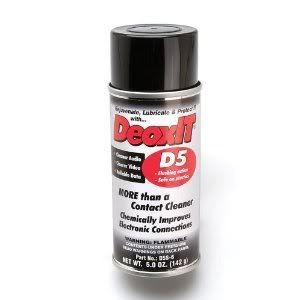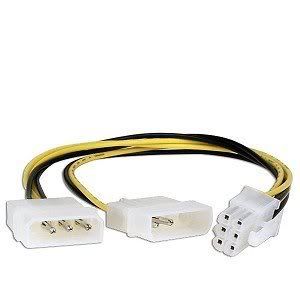So, we've talked about preventing problems by exercising all the controls and jacks. We've turned all the knobs and flipped all the switches and run a plug in and out of all the jacks. So anything still not working right needs more than just exercise. Almost everything here applies to pedals and guitar electronics as well as to amps.
Mostly we're going to approach this from the point of view of solving a problem. You may not need to address everything discussed here. If you've got a noisy switch or a jack that hums when nothing is plugged in you might not want to do the whole amp, especially if it is otherwise clean and in good shape. But if you've got something that's been left in a shed or has a lot of obscure noises, get it all.
Let me introduce my favorite product in the world. Caig Deoxit D5.
You need a can of this. It isn't cheap, $12 - 18 for the size shown but it will last a long time and do a tremendous amount of good while it lasts. There are other worthwhile contact cleaners, but as long as I've been using this I haven't needed another. The one thing that does not work is WD40. Save that for cleaning bike parts and keeping your tools from rusting. WD40 leaves a lot of oil behind that dries into a hard and unpleasant varnish. If you use it on something you will need to use it again because of it. Then you'll need something else to flush out all the old WD40.
One other reason to use D5, it is completely benign to tolex, plastic, guitar finishes (even nitrocellulose lacquer) and, so far as I can tell, human beings. Don't drink the stuff, but I have gotten it in my eye and even that doesn't burn. Here's the MSDS.
So get your can of D5 and some tools if that is where this next phase takes us. Notice that the nozzle turns to adjust the spray, you'll want that at the lowest setting.
Tube Sockets and Grotty Tube Pins
For tube sockets, give a small small spray either directly at the socket or on the tube pins and run the tube in and out of the socket. Allow to dry before firing up the amp. Some tube pins tend to corrode in really ugly ways. The pins on small 9 pin tubes, like 12AX7s require some very fancy metallurgy. Because they go through the glass they have to expand and contract with heat in a way that is compatible with the glass. Normal metals won't do this, so corrosion resistant alloys are out of the question. Use a shot of Deoxit and a bit of 3M scotch brite to clean heavy corrosion. Sandpaper also works. Never use a file on a tube pin it, the vibrations will damage the tube.
We test for dirty pins by firing up the amp and listening while pushing the tube around a little in the socket. Start with the controls set low, no reason to blast yourself. If there's a problem it will be obvious. So, clean, let dry, power up and test. Just put a finger tip on the top of the tube and move it gently. If one cleaning does not do the job, repeat it.
Control Pots
We need access to the controls for this. It is rarely rewarding to try to clean a pot by spraying around the shaft and hoping the cleaner gets in. It's worth a try as a desperation move on a sealed pot, but not normally worth it. So open up the amp. All the normal safety warnings apply. Unplug and use a DC voltmeter to ensure that the voltages in the amp have drained. If you don't understand that, do not proceed.
With the amp open, look at the pot in the area where the terminals come out to be soldered to the wires or to the circuit board. Generally there will be window in the metal can around the terminals. Some pots will also have a hole in the case.

A short spray into either of these openings followed by exercising the pot will do the job. These do not get hot so you can feel free to test immediately. Do be sure the amp is correctly connected and safe before applying power. The usual rule is that a pot that does not operate cleanly after two cleaning attempts should be replaced. Do know that some controls will always be a little noisy, the "Presence" control on Marshalls is one example. Some pedals will also misbehave like that.
As a general rule any pot with DC current flowing through it will make noise. This can be an important diagnostic tool. If you find a pot that is noisy when turned that does not improve with cleaning and you notice that the noisy spots in the pots rotation never move when you spray or exercise it you likely have a DC voltage on that pot. This can help locate a leaky coupling capacitor or failing opamp.
Jacks
A quick spritz of Deoxit into the jack an running a plug in and out will solve most jack problems. Including dirt on the shorting leaf of the input jacks on an amp. This is the introductory course so we won't talk about the use of a burnishing tool for the ones that don't respond. Again, if repeated cleaning attempts fail, it is probably best to replace the jack.
Everything Else
In most modern amps you are going to find connectors like this: And this.
And this.
 You'll find these push on connectors throughout many amps and almost always connecting speakers. It is good practice to clean them every few years, especially if you've got noise problems. Give the connector a short spray of D5 before removing it, this will make it a lot easier if there is any corrosion already there. Pull and push it back down a couple of times. On some amps, this could keep you busy awhile.
You'll find these push on connectors throughout many amps and almost always connecting speakers. It is good practice to clean them every few years, especially if you've got noise problems. Give the connector a short spray of D5 before removing it, this will make it a lot easier if there is any corrosion already there. Pull and push it back down a couple of times. On some amps, this could keep you busy awhile.Be careful of any connectors that aren't indexed. Make sure everything goes back just as it was. Some multi-pin connectors will have a latch or catch on them. Don't just yank - look.
This is also where you will find if a connector has been poorly soldered. If the pin or post comes out of the circuit board, it isn't because you did something wrong, it is because it already had a problem.
Switches
I do not recommend cleaning a malfunctioning power or standby switch. Once those have gone the least bit bad, they arc and destroy the contacts in a way that no cleaner will fix. It may not hurt to clean a functional switch, but remember that Deoxit is flammable and we do not want any fires in the amp. You'll find that most such switches are sealed anyway.
Signal switches are another matter entirely. Find an opening. Sometimes the only path into the switch is straight along the actuator shaft, usually with a spring in your way. Even those often have a small cutout on the top. You'll see if you've gotten in there. It doesn't take much. One of the important things to know about Deoxit is that the less you use the better.
The Important Trick
Using heat from a lighter or other source you can soften the spray tube and bend it into a convenient shape. Don't melt it, and don't do this on the can. Let me emphasize that do not spray Deoxit near a heat source or flame. Bend the straw then mount it to the can. The bent straw will get in a lot more places than the straight one.
The Short Version
Find all the connections in the amp, give them a shot of Deoxit and move them through their range of motion. Let dry and add power.
Congratulations. You should now have a quieter, sweeter sounding amp.

I love this page so much but supposedly I'm trying to look for waste disposal Etobicoke.
ReplyDelete